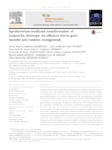Please use this identifier to cite or link to this item:
http://www.alice.cnptia.embrapa.br/alice/handle/doc/978312| Title: | Agrobacterium-mediated transformation of Guignardia citricarpa: an efficient tool to gene transfer and random mutagenesis. |
| Authors: | RODRIGUES, M. B. C.  FAVARO, L. C. de L.   PALLU, A. P. de S.   FERREIRA, A.   SEBASTIANES, F. de S.   RODRIGUES, M. J. C.   SPÓSITO, M. B.   ARAÚJO, W. L. de   PIZZIRANI-KLEINER, A. A.   |
| Affiliation: | Maria Beatriz Calderan Rodrigues, USP-ESALQ; LEIA CECILIA DE LIMA FAVARO, CNPAE; Ana Paula de Souza Pallu, USP-ESALQ; ANDERSON FERREIRA, CPAMT; Fernanda de Souza Sebastianes, USP-ESALQ; Maria Juliana Calderan Rodrigues, USP-ESALQ; Marcel Bellato Spósito, USP-ESALQ; Welington Luiz DE Araújo, UMC; Aline Aparecida Pizzirani-Kleiner, USP-ESALQ. |
| Date Issued: | 2013 |
| Citation: | Fungal Biology, Oxford, v. 117, n. 7/8, p. 556-568, jul./aug., 2013. |
| Description: | Guignardia citricarpa is the causal agent of Citrus Black Spot (CBS), an important disease in Citriculture. Due to the expressive value of this activity worldwide, especially in Brazil, understanding more about the functioning of this fungus is of utmost relevance, making possible the elucidation of its infection mechanisms, and providing tools to control CBS. This work describes for the first time an efficient and successful methodology for genetic transformation of G. citricarpa mycelia, which generated transformants expressing the gene encoding for the gfp (green fluorescent protein) and also their interaction with citrus plant. Mycelia of G. citricarpa were transformed via Agrobacterium tumefaciens, which carried the plasmid pFAT-gfp, contains the genes for hygromycin resistance (hph) as well as gfp. The optimization of the agrotransformation protocol was performed testing different conditions (type of membrane; inductor agent concentration [acetosyringonee - AS] and cocultivation time). Results demonstrated that the best condition occurred with the utilization of cellulose?s ester membrane; 200µM of AS and 96 h as cocultivation time. High mitotic stability (82 %) was displayed by transformants using Polymerase Chain Reaction (PCR) technique to confirm the hph gene insertion. In addition, the presence of gfp was observed inside mycelia by epifluorescence optical microscopy. This technique easy visualization of the behaviour of the pathogen interacting with the plant for the first time, allowing future studies on the pathogenesis of this fungus. The establishment of a transformation method for G. citricarpa opens a range of possibilities and facilitates the study of insertional mutagenesis and genetic knockouts, in order to identify the most important genes involved in the pathogenesis mechanisms and plant-pathogen interaction. |
| NAL Thesaurus: | Guignardia citricarpa genetic transformation citrus black spot |
| Keywords: | Agrobacterium-Mediated Plant-Pathogen Interaction |
| ISSN: | 1878-6146 |
| DOI: | http://dx.doi.org/10.1016/j.funbio.2013.06.005 |
| Type of Material: | Artigo de periódico |
| Access: | openAccess |
| Appears in Collections: | Artigo em periódico indexado (CPAMT)  |
Files in This Item:
| File | Description | Size | Format | |
|---|---|---|---|---|
| cpamtFerreira187861462013.pdf | 2,49 MB | Adobe PDF |  View/Open |









